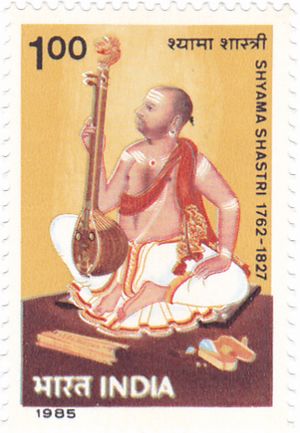Shyama Shastri facts for kids
Quick facts for kids
Shyama Shastri
|
|
|---|---|
 |
|
| Born |
Venkata Subrahmanya
26 April 1762 |
| Died | 1827 (aged 64-65) |
| Other names | Shyama Krishna |
| Occupation | Carnatic music composer |
Shyama Shastri (born April 26, 1762 – died 1827) was a very important musician and composer of Carnatic music. Carnatic music is a type of classical music from South India. He was the oldest of three famous composers known as the Trinity of Carnatic music. The other two were Tyagaraja and Muthuswami Dikshitar.
Contents
Early Life and Musical Journey
Shyama Shastri was born on April 26, 1762. His family was Telugu Brahmin, and they had moved from a place called Cumbum in Andhra Pradesh. He was born in Thiruvarur in what is now the state of Tamil Nadu.
From a young age, Shyama Shastri studied ancient texts called Vedas and learned about astrology. He also started learning music from his uncle. Later, a famous musician named Adiappayya taught him even more about music. Adiappayya worked at the royal court in Thanjavur.
His Unique Compositions
Shyama Shastri did not write as many songs as the other two famous composers. However, his songs are still very well-known. This is because they are very skilled in their words, tunes, and rhythms. People say he wrote about 300 pieces in total.
His music was quite complex and often appealed more to learned musicians than to everyone. Also, the language he used in his Telugu songs was more formal. This was different from Tyagaraja, who used more everyday Telugu. Shyama Shastri also wrote some songs in the Tamil language. Most of his songs praise the Goddess Kamakshi.
He wrote different types of songs, including kritis, varṇa(s), and svarajati(s). He always included his special signature, Śyāma Krishna, in his songs. He was probably the first to create a new kind of svarajati. These svarajati songs could be sung or played only as music. Before him, svarajati was mainly used for dance.
His three most famous svarajati songs are meant to be sung in concerts. They are sometimes called "Ratnatrayam" (which means "Three Jewels"). These songs are Kāmākṣhī Anudinamu, Kāmākṣhī Padayugamē, and Rāvē himagiri kumāri. They are set to different musical scales (ragas) like Bhairavi, Yadukula kambhoji, and Todi.
Shyama Shastri was known for his amazing ability to compose music using very complex tāḷas (rhythm cycles). People also admired his beautiful voice and singing during his time.
His Family and Students
Shyama Shastri passed away in Thanjavur in 1827. He had two sons, Panju Shastri and Subbaraya Shastri. Panju was a devoted follower of the goddess Bangaru Kamakshi. Subbaraya learned music from his father and became a talented composer. He was also a skilled player of the veena, a string instrument. His father also asked Tyagaraja, another famous composer, to teach Subbaraya. Shyama Shastri's adopted grandson, Annasvami Shastri (1827–1900), was also a great composer.
Shastri had many students who became excellent musicians. Alasur Krishna Iyer became a musician at the royal court in Mysore. Porambur Krishna Iyer helped make many of his teacher's songs popular. Another student, Talagambadi Panchanada Iyer, also became a composer. Another student named Dasari became famous as a nāgaswaram player.
Important Compositions
Shyama Shastri composed many beautiful pieces. Here are some of the types of songs he wrote:
Svara Jati Songs
His svara jati songs are special. They are meant for singing in concerts. His "Three Jewels" (Ratnatrayam) are examples of these.
| Composition | Raga (Musical Scale) | Tāḷa (Rhythm) | Language |
|---|---|---|---|
| Kāmākṣhī anudinamu maruvakanē | Bhairavi | Miśra Cāpu | Telugu |
| Kāmākṣhī nī padayugame sthiramaninē | Yadukulakamboji | Miśra Cāpu | Telugu |
| Rāvē himagiri kumāri | Todi | Ādi | Telugu |
Kriti Songs
He also composed many kriti songs. These are a very common type of Carnatic music composition.
| Composition | Raga (Musical Scale) | Tāḷa (Rhythm) | Language |
|---|---|---|---|
| Śaṅkari Śaṃkuru candra mukhī | Sāvēri | Ādi – Tiśra Gati | Sanskrit |
| Birāna varālicci brōvave | Kaḷyāṇi | Ādi – Tiśra Gati | Telugu |
| Himādri sutē pāhimāṃ | Kaḷyāṇi | Ādi | Sanskrit |
| Māyammā yani nē pilacite | Ahiri | Ādi | Telugu |
| Mari vērē gati evvarammā | Anandabhairavi | Miśra Cāpu | Telugu |
| O jagadambā nannu | Anandabhairavi | Ādi | Telugu |
| Sarōja daḷa nētri himagiri putrī | śaṃkarābharaṇaṃ | Ādi | Telugu |
| Tallī ninnu nera namminānu vinavē | Kaḷyāṇi | Miśra Cāpu | Telugu |
| Ennēramum un Nāmam | Pūrvikalyāni | Misra caapu | Tamil |
| Ennēramum un Pāda Kamalam | Punnāgavarāḷi | Miśra Cāpu | Tamil |

